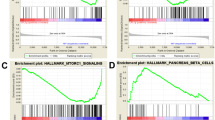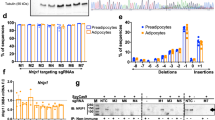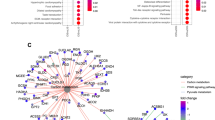Abstract
Background/Objectives:
Replication initiator 1 (Repin1) gene encodes for a zinc-finger protein and has been implicated in the regulation of adipocyte cell size and glucose transport in vitro. Here, we investigate the consequences of reduced adipose tissue (AT) Repin1 expression in vivo.
Subjects/Methods:
We have inactivated the Repin1 gene in adipose tissue (iARep−/−) at an age of 4 weeks using tamoxifen-inducible gene targeting strategies on the background of C57BL/6NTac mice. Furthermore, we differentiated human primary adipocytes derived from subcutaneous AT in vitro and knocked down REPIN1 using siRNA technique to measure glycerol release.
Results:
Conditional Repin1 inactivation results in decreased AT mass, smaller adipocytes in both, subcutaneous and epigonadal AT compared to controls. Compared to controls, iARep−/− mice were more insulin sensitive, had better glucose tolerance and lower LDL-, HDL- and total cholesterol. Significantly lower AT expression of the Repin1 target genes Cd36 and Lcn2 may contribute to the phenotype of iARep−/− mice. Knockdown of REPIN1 in human in vitro differentiated adipocytes revealed an increased glycerol release.
Conclusions:
In conclusion, deficiency of Repin1 in AT causes alterations in AT morphology and function, which may underlay lower body weight and improved parameters of insulin sensitivity, glucose and lipid metabolism.
This is a preview of subscription content, access via your institution
Access options
Subscribe to this journal
Receive 12 print issues and online access
$259.00 per year
only $21.58 per issue
Buy this article
- Purchase on SpringerLink
- Instant access to full article PDF
Prices may be subject to local taxes which are calculated during checkout




Similar content being viewed by others
References
Caddle MS, Dailey L, Heintz NH . RIP60, a mammalian origin-binding protein, enhances DNA bending near the dihydrofolate reductase origin of replication. Mol Cell Biol 1990; 10: 6236–6243.
Dailey L, Caddle MS, Heintz N, Heintz NH . Purification of RIP60 and RIP100, mammalian proteins with origin-specific DNA-binding and ATP-dependent DNA helicase activities. Mol Cell Biol 1990; 10: 6225–6235.
Houchens CR, Montigny W, Zeltser L, Dailey L, Gilbert JM, Heintz NH . The dhfr oribeta-binding protein RIP60 contains 15 zinc fingers: DNA binding and looping by the central three fingers and an associated proline-rich region. Nucleic Acids Res 2000; 28: 570–581.
Klöting N, Wilke B, Klöting I . Triplet repeat in the Repin1 3'-untranslated region on rat chromosome 4 correlates with facets of the metabolic syndrome. Diabetes/Metab Res Rev 2007; 23: 406–410.
Kovács P, Klöting I . Quantitative trait loci on chromosomes 1 and 4 affect lipid phenotypes in the rat. Arch Biochem Biophys 1998; 354: 139–143.
Ruschke K, Illes M, Kern M, Klöting I, Fasshauer M, Schön MR et al. Repin1 maybe involved in the regulation of cell size and glucose transport in adipocytes. Biochem Biophys Res Commun 2010; 400: 246–251.
Kern M, Kosacka J, Hesselbarth N, Brückner J, Heiker JT, Flehmig G et al. Liver-restricted Repin1 deficiency improves whole-body insulin sensitivity, alters lipid metabolism, and causes secondary changes in adipose tissue in mice. Diabetes 2014; 63: 3295–3309.
Kunath A, Hesselbarth N, Gericke M, Kern M, Dommel S, Kovacs P et al. Repin1 deficiency improves insulin sensitivity and glucose metabolism in db/db mice by reducing adipose tissue mass and inflammation. Biochem Biophys Res Commun 2016; 478: 398–402.
Kern M, Klöting N, Niessen HG, Thomas L, Stiller D, Mark M et al. Linagliptin improves insulin sensitivity and hepatic steatosis in diet-induced obesity. PloS One 2012; 7: e38744.
Sassmann A, Offermanns S, Wettschureck N . Tamoxifen-inducible Cre-mediated recombination in adipocytes. Genesis (New York, NY: 2000) 2010; 48: 618–625.
Klöting N, Koch L, Wunderlich T, Kern M, Ruschke K, Krone W et al. Autocrine IGF-1 action in adipocytes controls systemic IGF-1 concentrations and growth. Diabetes 2008; 57: 2074–2082.
Tschöp MH, Speakman JR, Arch, Jonathan RS, Auwerx J, Brüning JC et al. A guide to analysis of mouse energy metabolism. Nat Methods 2011; 9: 57–63.
Hesselbarth N, Pettinelli C, Gericke M, Berger C, Kunath A, Stumvoll M et al. Tamoxifen affects glucose and lipid metabolism parameters, causes browning of subcutaneous adipose tissue and transient body composition changes in C57BL/6NTac mice. Biochem Biophys Res Commun 2015; 464: 724–729.
Du Plessis J, van Pelt J, Korf H, Mathieu C, van der Schueren B, Lannoo M et al. Association of adipose tissue inflammation with histologic severity of nonalcoholic fatty liver disease. Gastroenterology 2015; 149: 635–48.e14.
Eriksson Hogling D, Petrus P, Gao H, Bäckdahl J, Dahlman I, Laurencikiene J et al. Adipose and circulating CCL18 levels associate with metabolic risk factors in women. J Clin Endocrinol Metab 2016; 101: 4021–4029.
Hellmér J, Marcus C, Sonnenfeld T, Arner P . Mechanisms for differences in lipolysis between human subcutaneous and omental fat cells. J Clin Endocrinol Metab 1992; 75: 15–20.
Heiker JT, Klöting N . Replication initiator 1 in adipose tissue function and human obesity. Vitam Horm 2013; 91: 97–105.
Ye R, Wang QA, Tao C, Vishvanath L, Shao M, McDonald JG et al. Impact of tamoxifen on adipocyte lineage tracing: Inducer of adipogenesis and prolonged nuclear translocation of Cre recombinase. Mol Metab 2015; 4: 771–778.
Cannon B, Nedergaard J . Brown adipose tissue: function and physiological significance. Physiol Rev 2004; 84: 277–359.
Yoneshiro T, Aita S, Matsushita M, Kameya T, Nakada K, Kawai Y et al. Brown adipose tissue, whole-body energy expenditure, and thermogenesis in healthy adult men. Obesity (Silver Spring, Md) 2011; 19: 13–16.
Spartano NL, Stevenson MD, Xanthakis V, Larson MG, Andersson C, Murabito JM et al. Associations of objective physical activity with insulin sensitivity and circulating adipokine profile: the Framingham Heart Study. Clin Obes 2017; 7: 59–69.
Kennedy DJ, Kuchibhotla SD, Guy E, Park YM, Nimako G, Vanegas D et al. Dietary cholesterol plays a role in CD36-mediated atherogenesis in LDLR-knockout mice. Arterioscler Thromb Vasc Biol 2009; 29: 1481–1487.
Febbraio M, Abumrad NA, Hajjar DP, Sharma K, Cheng W, Pearce SF et al. A null mutation in murine CD36 reveals an important role in fatty acid and lipoprotein metabolism. J Biol Chem 1999; 274: 19055–19062.
Seale P, Kajimura S, Yang W, Chin S, Rohas LM, Uldry M et al. Transcriptional control of brown fat determination by PRDM16. Cell Metab 2007; 6: 38–54.
Kajimura S, Seale P, Tomaru T, Erdjument-Bromage H, Cooper MP, Ruas JL et al. Regulation of the brown and white fat gene programs through a PRDM16/CtBP transcriptional complex. Genes Dev 2008; 22: 1397–1409.
Wang Y, Lam KS, Kraegen EW, Sweeney G, Zhang J, Tso AW et al. Lipocalin-2 is an inflammatory marker closely associated with obesity, insulin resistance, and hyperglycemia in humans. Clin Chem 2007; 53: 34–41.
Guo H, Jin D, Zhang Y, Wright W, Bazuine M, Brockman DA et al. Lipocalin-2 deficiency impairs thermogenesis and potentiates diet-induced insulin resistance in mice. Diabetes 2010; 59: 1376–1385.
Yan Q, Yang Q, Mody N, Graham TE, Hsu C, Xu Z et al. The adipokine lipocalin 2 is regulated by obesity and promotes insulin resistance. Diabetes 2007; 56: 2533–2540.
Law IK, Xu A, Lam KS, Berger T, Mak TW, Vanhoutte PM et al. Lipocalin-2 deficiency attenuates insulin resistance associated with aging and obesity. Diabetes 2010; 59: 872–882.
Fasshauer M, Blüher M . Adipokines in health and disease. Trends Pharmacol Sci 2015; 36: 461–470.
Acknowledgements
We would like to thank Viola Döbel, Eva Böge, Daniela Kern and Susan Berthold of University of Leipzig for technical assistance. We also want to thank Prof Dr Stefan Offermanns and Dr Antonia Sassmann from Max-Planck-Institute for Heart and Lung Research in Bad Nauheim, Germany, for providing Adipoq–Cre+/− mice. This work was supported by the research group ‘SFB1052/2’, B1 (to MB); B4 (to NK) funded by Deutsche Forschungsgemeinschaft and supported by the Federal Ministry of Education and Research (BMBF), Germany, IFB AdiposityDiseases FKZ: 01EO1501 (N. Klöting), DZD (82DZD00601), DDG (934300-003), by the Helmholtz Alliance ICEMED—Imaging and Curing Environmental Metabolic Diseases, through the Initiative and Networking Fund of the Helmholtz Association, the Swedish Research Council, The Swedish Diabetes Foundation, CIMED, the Diabetes Theme Center at Karolinska Institutet, the Stockholm County Council and the Novo Nordisk Foundation.
Author information
Authors and Affiliations
Corresponding author
Ethics declarations
Competing interests
The authors declare no conflict of interest.
Additional information
Supplementary Information accompanies this paper on International Journal of Obesity website
Supplementary information
Rights and permissions
About this article
Cite this article
Hesselbarth, N., Kunath, A., Kern, M. et al. Repin1 deficiency in adipose tissue improves whole-body insulin sensitivity, and lipid metabolism. Int J Obes 41, 1815–1823 (2017). https://doi.org/10.1038/ijo.2017.172
Received:
Revised:
Accepted:
Published:
Issue date:
DOI: https://doi.org/10.1038/ijo.2017.172
This article is cited by
-
REPIN1 regulates iron metabolism and osteoblast apoptosis in osteoporosis
Cell Death & Disease (2023)
-
Metabolic effects of genetic variation in the human REPIN1 gene
International Journal of Obesity (2019)
-
Liver-specific Repin1 deficiency impairs transient hepatic steatosis in liver regeneration
Scientific Reports (2018)



